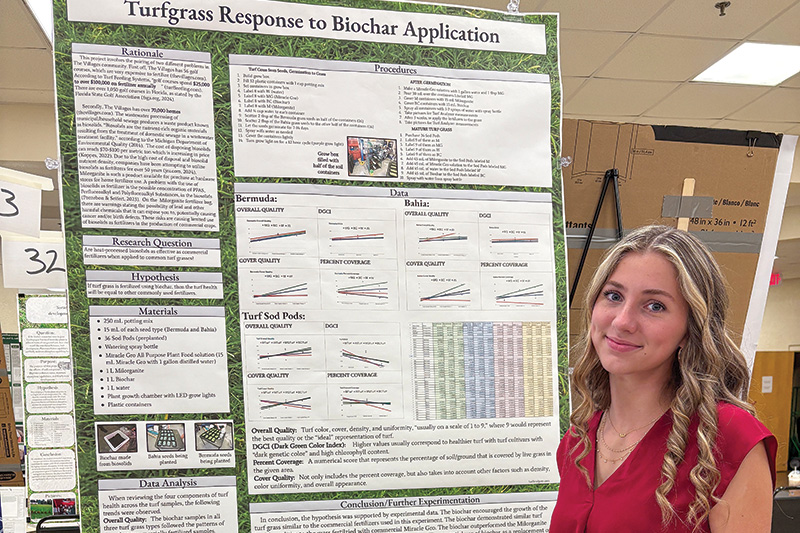
Sarah Colley with her presentation for her biochar experiment project at the Regeneron International Science and Engineering Fair in Columbus, Ohio, this spring. Photo courtesy of Sarah Colley
A science fair project by a Florida high school student has the potential to benefit golf course maintenance while improving environmental sustainability.
The project by Sarah Colley — a sophomore at The Villages High School in Middleton, Fla. — aims to determine whether recycled sewage could be a viable substitute for fertilizer on golf courses, while reducing the need to dispose of the sewage in costly ways unfriendly to the environment. For her project, Colley compared a recycled sewage product called biochar to common MiracleGro fertilizer when applied to bermudagrass and bahiagrass grown under lights in her garage. Her initial results determined biochar to yield comparable results to the MiracleGro fertilizer.
Colley presented her project, “Turfgrass Response to Biochar Application,” at the Regeneron International Science and Engineering Fair in Columbus, Ohio, this spring. She qualified for the competition with 1,600 students by placing in a Florida regional science fair. She didn’t win any awards this year but is continuing her project into next year.
Colley said she became interested in the project because of two seemingly related issues.
“A big expense of golf courses is fertilizer. Another big expense is the cost of human biosolids, the product of wastewater treatment plants — basically what’s left over from turning wastewater into freshwater,” Colley said.
Jacobs Engineering (the provider of utilities for the Villages Community Development District) produces the biochar product by superheating biosolids from wastewater treatment. As it is not yet commercially available, a sponsor from the company worked with Colley to provide her with biochar for her project.
Colley said there are commercial products available similar to biochar, but they have PFAS chemicals — per- and polyfluoroalkyl substances — that persist in the environment and pose potential health risks. She said the biochar product in her project has been produced to burn off these PFAS.
“These are harmful to organisms because they accumulate in their bodies and go up the food chain, and once they reach humans, they can cause thyroid issues, fertility issues and potentially cancer. So, the best thing about biochar is that it’s 100% free of the PFAS chemicals,” Colley said.
“I showed that biochar could be as efficient as other fertilizers when applied to turf,” she said. “And it doesn’t have the PFAS chemicals that nobody wants because they are so bad for the environment.”
To test her data, Colley said she used the phone app TurfAnalyzer. “You take a picture of a turfgrass sample and upload it, and it compares your picture to what stereotypical healthy turf looks like,” she said. “It gives you 17 categories of data, and I used four — overall quality, percent coverage, cover quality and dark green color index, which represents high chlorophyll activity. I did support my hypothesis. I proved that the (turf) did react very similarly to biochar as the MiracleGro,” Colley said. “So, the biochar could be used as a replacement fertilizer when applied to golf course turf.”
For the next phase of her project this summer, Colley will conduct the same experiment, only on a grass plot at the local Villages Executive Golf. As part of her project, Colley gave a presentation to the Villages staff, said Donald Jones, GCSAA Class A director of executive golf maintenance.
“You could tell that she was not expecting that many people to be present for the presentation, but that did not hold her back from rising to the occasion to tell her story and what her goals were of this project,” said Jones, a 14-year GCSAA member. “We have a great opportunity to help kids that may not know what they want to do when they graduate.”
For her part, Colley said she doesn’t think she’ll pursue turfgrass in college and that this project was more “just for the experience.”
“Right now, I think I’ll pursue radiology, but it’s still up in the air. I’m only 16,” she said.
Phil Cauthon is GCM's managing editor